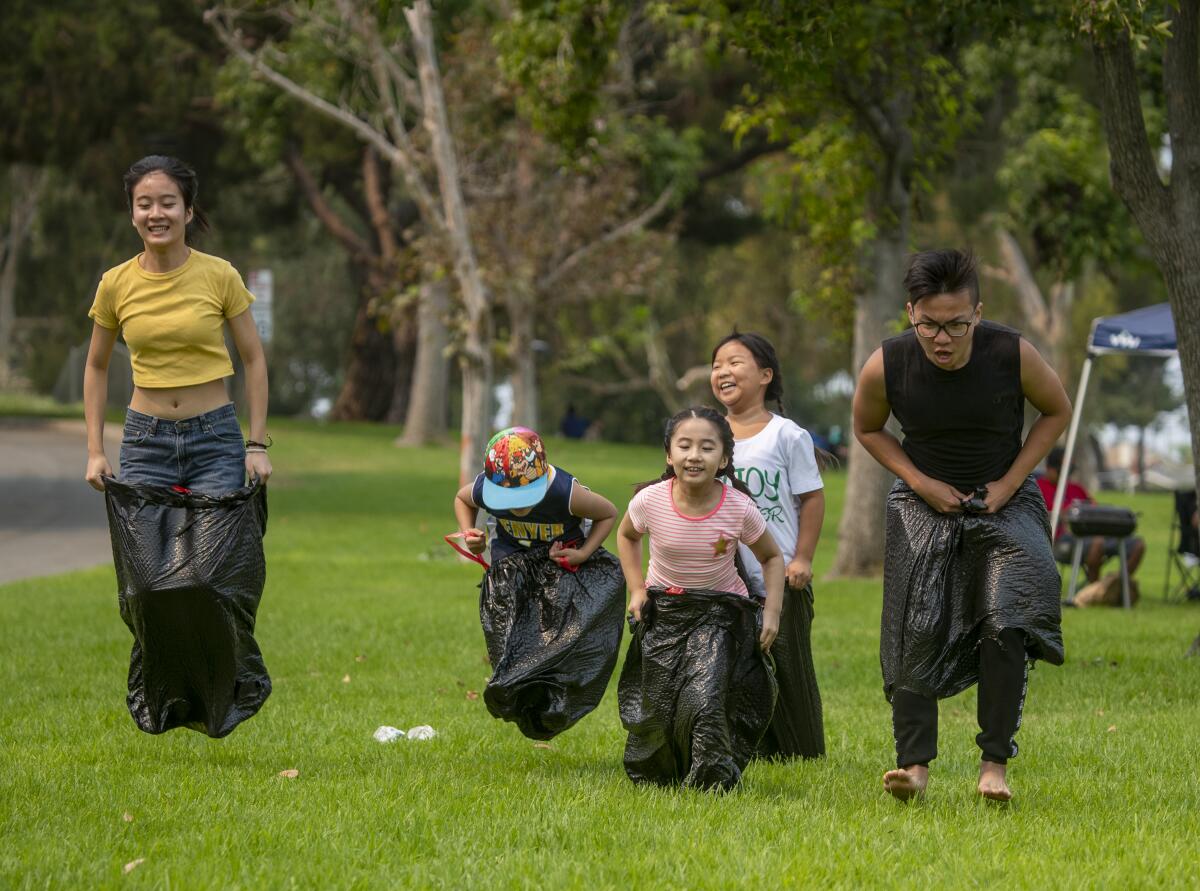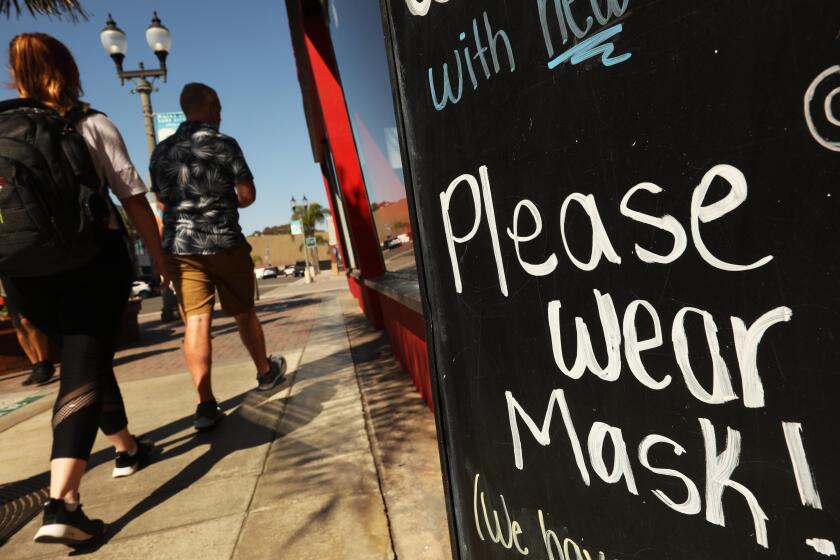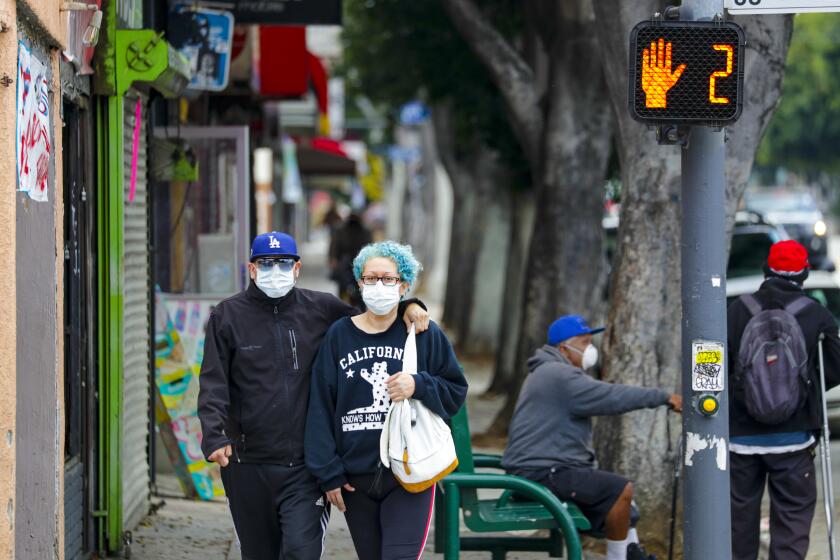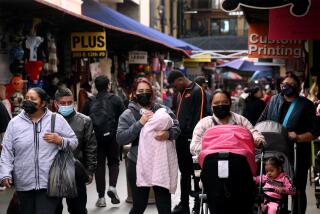State continues to see a decline in COVID-19 cases and hospitalizations, but will it last?

- Share via
The number of COVID-19 cases and hospitalizations continues to decline in California, but the virus’ full impact is on delay.
Gov. Gavin Newsom on Tuesday reported a 24% decline in statewide hospitalizations over a 14-day period and said that the seven-day average for positive infections is now 3.8%.
That metric — which is the number of total tests divided by the number of positive infections — is the lowest the state has seen since late May and the state’s first attempt at reopening, according to a Times analysis. At that time, the positivity rate hovered around 4.0%, before spiking to 8% after an accelerated reopening of the state’s business sectors and mass holiday gatherings over Memorial Day and the Fourth of July.
The state has also reached a higher capacity for testing, with more than 113,890 daily tests over a seven-day average.
Despite the progress, Newsom warned that activity from Labor Day could lead to an influx in cases.
“Three-day holiday weekends have not been advantageous in terms of the mitigation of the spread of this virus,” Newsom said. “You look back at some seminal periods, where we experienced larger spread, and [a] large surge of transmission tended to occur two to three weeks after, say, Fourth of July and other holiday weekends. As a consequence, we’re very cautious in terms of our approach as we move forward.”
Los Angles County Public Health Director Barbara Ferrer issued a similar warning Wednesday, pointing to past surges in transmission related to the Fourth of July.
“Our collective actions do have a life-and-death consequence,” she said.
Ferrer was “cautiously hopeful” that case counts would not increase drastically in the weeks after Labor Day. But if a surge in hospitalizations and infections do occur, Ferrer said, “we will need to take some action.”
“All of this is really dependent on doing our best job every day to drive down the transmission,” she said. Ferrer recommended that anyone who was in a crowd over the holiday weekend or came into contact with someone who was feeling sick or tested positive for the virus should get tested.
The state’s new reopening guidelines, which rely on a four-tiered system based on the risk of spread, requires a county to meet the requirements in its tier for three consecutive weeks before advancing.
Because it takes about two weeks for new infections to be reported, any upcoming moves would likely align with data gleaned from activity over the holiday weekend and the state’s latest reopening plans.
Orange County joins San Diego as the only counties in Southern California not having “widespread risk” under the state’s COVID-19 monitoring system.
Five more counties — including Orange — moved into the next stage of state’s reopening system this week, decreasing the total number of counties on the widespread Tier 1 from 38 to 33.
Movement through the tiers is based primarily on two key metrics: positive case counts per population and positive cases measured by the number of total tests. If a county falls across two tiers — as is the case with Los Angeles County — the more stringent restrictions apply.
The county, which reported 61 additional COVID-19 deaths and 671 new cases Wednesday, has a seven-day average positivity rate of less than 5%. That metric aligns with the state’s Tier 2, but the county’s case rate per 100,000 exceeds the requirement for moving into that stage.
The survey offers further proof that Black and Latino households often experience the heaviest financial fallout from the coronavirus outbreak.
As understanding of the virus continues to evolve, experts and officials have warned that it’s crucial for residents to remain vigilant in maintaining social distancing practices, especially as flu season approaches.
In audio recordings between President Trump and journalist Bob Woodward released Wednesday, Trump is heard in a conversation from February telling Woodward that the coronavirus is deadlier than the flu. Trump’s comments do not align with what he or the Centers for Disease Control and Prevention shared at the time, when the messaging was that the flu was deadlier than the virus.
Later in March, Trump told Woodward that he played down the reality of the virus’ impact in order to prevent panic.
“I wanted to always play it down. I still like playing it down because I don’t want to create a panic,” Trump said.
In Los Angeles County, where several Halloween-related activities such as trick-or-treating have been recommended against, officials have encouraged residents to get a flu vaccine early in the season.
More to Read
Sign up for Essential California
The most important California stories and recommendations in your inbox every morning.
You may occasionally receive promotional content from the Los Angeles Times.













